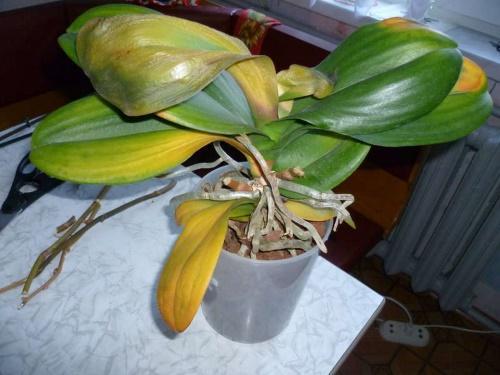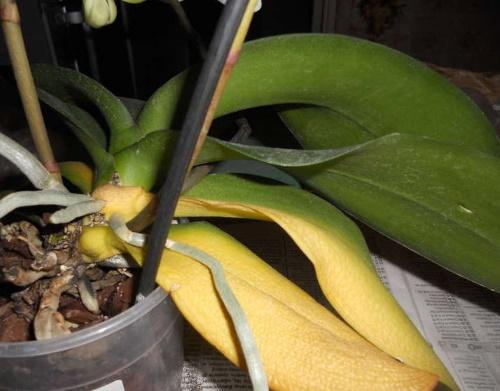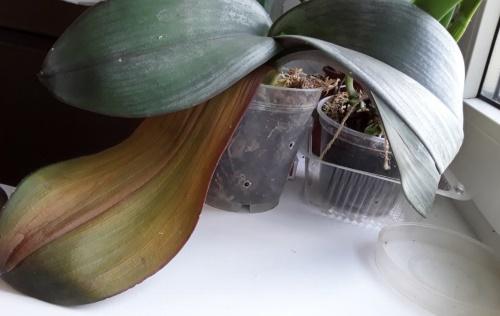Why do Phalaenopsis leaves turn yellow and what to do
 Orchids are the most beautiful flowers and are very popular with flower growers. They are moderately capricious, if you know what the plants like, but often the leaves of the epiphytes acquire a yellow tint. There can be many reasons why the leaves of phalaenopsis turn yellow, and they are not always related to the disease. Most often, this is caused by violations in the rules of caring for tropical beauties. In an effort to please them, we simply "love" our green pets, watering or feeding them. And the room climate does not differ enviable constancy. During the heating season, orchids can suffer from cold and dry air, and in summer - from the sun scorching in the windows. How can we help the flowers and prevent their death?
Orchids are the most beautiful flowers and are very popular with flower growers. They are moderately capricious, if you know what the plants like, but often the leaves of the epiphytes acquire a yellow tint. There can be many reasons why the leaves of phalaenopsis turn yellow, and they are not always related to the disease. Most often, this is caused by violations in the rules of caring for tropical beauties. In an effort to please them, we simply "love" our green pets, watering or feeding them. And the room climate does not differ enviable constancy. During the heating season, orchids can suffer from cold and dry air, and in summer - from the sun scorching in the windows. How can we help the flowers and prevent their death?
Why do Phalaenopsis leaves turn yellow?

- violation of the watering regime;
- unsuitable water;
- too bright lighting;
- nutritional deficiency or excess;
- disease.
Orchid leaves have their own "lifespan" and with age, the old ones simply die off. If only 1-2 lower leaves turn yellow, and the rest are elastic and green, it's okay. This is a natural process, as the plant gets rid of too old foliage to provide food for the young.
Overfilling or overdrying
The water regime has a direct effect on the condition and appearance of the phalaenopsis leaf plates:
- Lack of moisture can cause infrequent or improper watering. Water your plant more often based on the color of the roots. As soon as they have acquired a gray tint, and the pot itself has become much lighter - it's time to water. And it's better to do it by immersion. When watering directly into the pot, the water can quickly drain away, and the bark does not have time to get moisture. Accordingly, the Phalaenopsis itself will not get water from where. The leaves will begin to turn yellow and lose turgor.

- Excess moisture. Watering too often is more dangerous. It can cause root rot and death of the entire plant. In this case, the leaves first turn yellow, and then become covered with wet spots. The roots also darken, and even buds may crumble. To save the plant, transplant it into a new substrate. Before that, clean from rotten roots and diseased leaves and let dry well.

Wrong water
To water Phalaenopsis, however, like other indoor flowers, need settled water, preferably rainwater. But there is one caveat: epiphytes prefer warm water, so warm it up. And from hard water salts are deposited in the bark, disrupting the nutrition of the plant.
Orchids love slightly acidified water: add a little citric acid.
Excess lighting
Under natural conditions, epiphytes grow under the crown of trees and are never exposed to bright sun. If your flower is on the south window, it will feel bad there in summer. The leaves will not only turn yellow, but also become covered with ugly spots - burns.
Move the pot to another place, you can even on the bedside table by the window, where the curtain will scatter the sun's rays.
Overfeeding or lack of nutrients
 Orchids growing naturally on trees are fed by plant debris in the bark. In pots, they are completely dependent on us and need regular feeding. To do this, use special mineral complexes for orchids.
Orchids growing naturally on trees are fed by plant debris in the bark. In pots, they are completely dependent on us and need regular feeding. To do this, use special mineral complexes for orchids.
If you "fed" your phalaenopsis, you will have to change the substrate. After all, it was in it that the "shock dose" of microelements was collected.
Orchid diseases
 With a regulated regime of fertilizing and watering and a correctly selected place for orchids, yellowing of the foliage may indicate the presence of diseases. Most often, our indoor epiphytes get sick with fusarium fungus and other fungal infections. Here you cannot do without fungicides and replacing the soil mixture with a fresh substrate.
With a regulated regime of fertilizing and watering and a correctly selected place for orchids, yellowing of the foliage may indicate the presence of diseases. Most often, our indoor epiphytes get sick with fusarium fungus and other fungal infections. Here you cannot do without fungicides and replacing the soil mixture with a fresh substrate.